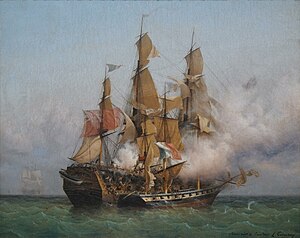
| Part of a series on |
| War (outline) |
|---|
 |
A privateer is a private person or vessel which engages in maritime warfare under a commission of war.[1] Since robbery under arms was a common aspect of seaborne trade, until the early 19th century all merchant ships carried arms. A sovereign or delegated authority issued commissions, also referred to as letters of marque, during wartime. The commission empowered the holder to carry on all forms of hostility permissible at sea by the usages of war. This included attacking foreign vessels and taking them as prizes and taking crews prisoner for exchange. Captured ships were subject to condemnation and sale under prize law, with the proceeds divided by percentage between the privateer's sponsors, shipowners, captains and crew. A percentage share usually went to the issuer of the commission (i.e. the sovereign).
Privateering allowed sovereigns to raise revenue for war by mobilizing privately owned armed ships and sailors to supplement state power. For participants, privateering provided the potential for a greater income and profit than obtainable as a merchant seafarer or fisher. However, this incentive increased the risk of privateers turning to piracy when war ended.
The commission usually protected privateers from accusations of piracy, but in practice the historical legality and status of privateers could be vague. Depending on the specific sovereign and the time period, commissions might be issued hastily; privateers might take actions beyond what was authorized in the commission, including after its expiry. A privateer who continued raiding after the expiration of a commission or the signing of a peace treaty could face accusations of piracy. The risk of piracy and the emergence of the modern state system of centralised military control caused the decline of privateering by the end of the 19th century.
- ^ Thomson, Janice E (1994). Mercenaries, pirates and sovereigns. New Jersey, United States: Princeton University Press. pp. 310/3153. ISBN 9780691086583.